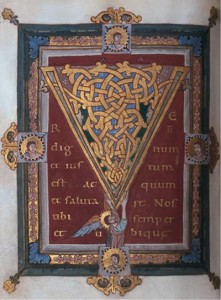It is Right and Just
One of the features of the post-Vatican II mass is that it is a dialogue between the priest and the people. The whole congregation is engaged with the liturgy because there are many “parts for the people”. At the end of the main prayers of the mass we are invited to signal our agreement with the content of the prayer by uttering the “Amen”. The most significant of these Amen responses is the “Great Amen” at the end of the Eucharistic Prayer.
Agreement is what is most frequently asked of the people, but there is one small dialogue where the people introduce an idea and the priest agrees with the congregation. It comes at the Introduction to the Preface of the Eucharistic Prayer:
P. The Lord be with you.

Illuminated “V” of “Vere dignum et iustum est” in a preface in the 1065 AD Tyniec Sacramentary (Photo from Wikimedia Commons)
A. And with your spirit.
P. Lift up your hearts.
A. We lift them up to the Lord.
P. Let us give thanks to the Lord our God.
A. It is right and just.
This dialogue which dates back to at least the third century, starts with the familiar exchange about the Lord and the Spirit, then the Latin has “Sursum corda” which, if it were to be translated word-for-word would be “Lift hearts”. The Eucharistic Prayer is, as the word “eucharist” suggests, all about giving thanks, and the priest is exhorting the congregation to adopt an appropriate “attitude of gratitude”. He then signals that the prayer is going to commence, and note that even though the priest says most of the Eucharistic Prayer alone, he is speaking on behalf of the congregation, so it is the plural pronoun: “Let us give thanks to Lord our God.”
It is at the very end of the dialogue that the people introduce a new idea; that thanking the Lord is right and just, that it is due and proper to offer our gratitude to the Lord our God..
The priest responds to this new idea in the opening line of the preface. The wording of the preface varies from day to day, but in Latin they all begin with the words “Vere dignum et iustum est ...” – “It is truly right and just ...”. This is what an artist illustrated in the page from the Tyniec Sacramentary about one thousand years ago. An angel is holding aloft a big letter “V” surrounded by the text of the preface. The “V” is filled with scrollwork suggesting a vine and hinting at the chalice of wine which will be held aloft during the Eucharistic prayer.
The dynamic translation used in the 1970s was out to communicate ideas rather than exact equivalences. As a result the prefaces we have been hearing for the last forty years have begun with a range of phrases all meant to convey the idea of “Vere dignum et iustum est ...”. This variation has perhaps obscured the fact that the priest is responding to, and agreeing with the people, picking up their exact words and emphasising them.
From Advent of this year, when the New Zealand Missal is in use in our parishes, we will hear every preface begin with the phrase “It is truly right and just” as the priest echoes and affirms what the people have said. The repetition might move an artist among us to beautifully illuminate that phrase. It is intended to move all of us.

 Entries(RSS)
Entries(RSS)